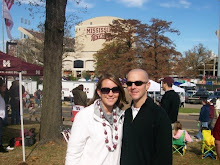Before I began reading this book, I decided to take a picture walk. As I flipped through the pages looking at the illustrations and photographs, I tried very hard not to read the quotes that accompanied some of them just yet. This was very hard to keep from doing, so occasionally I gave in and read them (I wanted to spend time looking at the pictures before I began because they were so intriguing).
I learned many new things reading this book. This book is the first one that I have read that gives background information on Ruby Bridges’ parents and grandparents. It also talks about why she was the child chosen to go to the all-white school. After she did well on the academic exam that was required, the NAACP visited her parents to convince them to let Ruby attend William Frantz, the all-white school. I could never imagine having to make that difficult decision. There is a quote on one page from Lucille Bridges, Ruby’s mother. In this quote Lucille talks about how she thought that it would be a wonderful opportunity for Ruby to go to a new school. Not until she had taken Ruby to school the first morning, returned home, and began watching television did she see how serious things really were just because a six year old had received a wonderful opportunity. She said that after seeing that the world was watching Ruby she was afraid.
After reading this, I wonder that if they knew what they were really going to be getting themselves into, would Ruby still have attended William Frantz. They had no idea that very angry protestors and federal marshals would surround them during their walk into the school. This book went into detail describing what happened before, during, and after integration. The photographs and paintings were absolutely amazing. The pictures were able to tell the story for themselves.
To be able to hear about integration from a person that played such a major role was amazing. Ruby's ability to recall what happened and draw the reader in was wonderful. This is a wonderful book for a variety of ages. I would give it to my first graders during our study of Ruby Bridges. Even if they did not have the ability to read the text yet, the pictures are able to tell a lot of the story by themselves. Students can learn a lot from this great book!!!
Tuesday, June 12, 2007
Subscribe to:
Post Comments (Atom)


2 comments:
I see that we felt very much in the same way regarding this book! It was a very powerful book to read. I read the text on the page next to the photographs, then spent more time analyzing each photo and caption. I especially liked the quotes from different people at the bottom of each page. I was very shocked at the photo of the demonstrator that held a black baby doll in a coffin. I can't imagine what Ruby thought as she saw that and remembered it years later.
Another related book that I read is Iggie's House by Judy Blume. It is a fictional story of a black family that moves into an all white suburban neighborhood in the early 70's. It's told from the perspective of a white girl who wants to be friends but doesn't understand why the grown-ups around her are all upset. I read this to my students a couple of years ago and they had strong reactions. It then led to discussions of Ruby Bridges and we saw the movie. Now I can add this book to my collection of books that we read when discussing the Civil Rights Movement in social studies!
There are so many books that have been published in the last few years to help us learn about what events led to the integration of schools and other public places. Although I lived during the time when things were segregated, I always wondered why. Why are there water fountains and restrooms for "whites" and "coloreds"? Why did black people have to sit in the back of the bus? Why? Why? Why? We've come a long way but there is still so much to do. Neighborhood schools are often segregated today. We have only to look around us in our graduate class to see how segregated our schools are today. Does everyone have equal opportunities? It took people like Ruby Bridges and her family to get things started. I wonder what we could do today to continue making schooling more equal?
Post a Comment